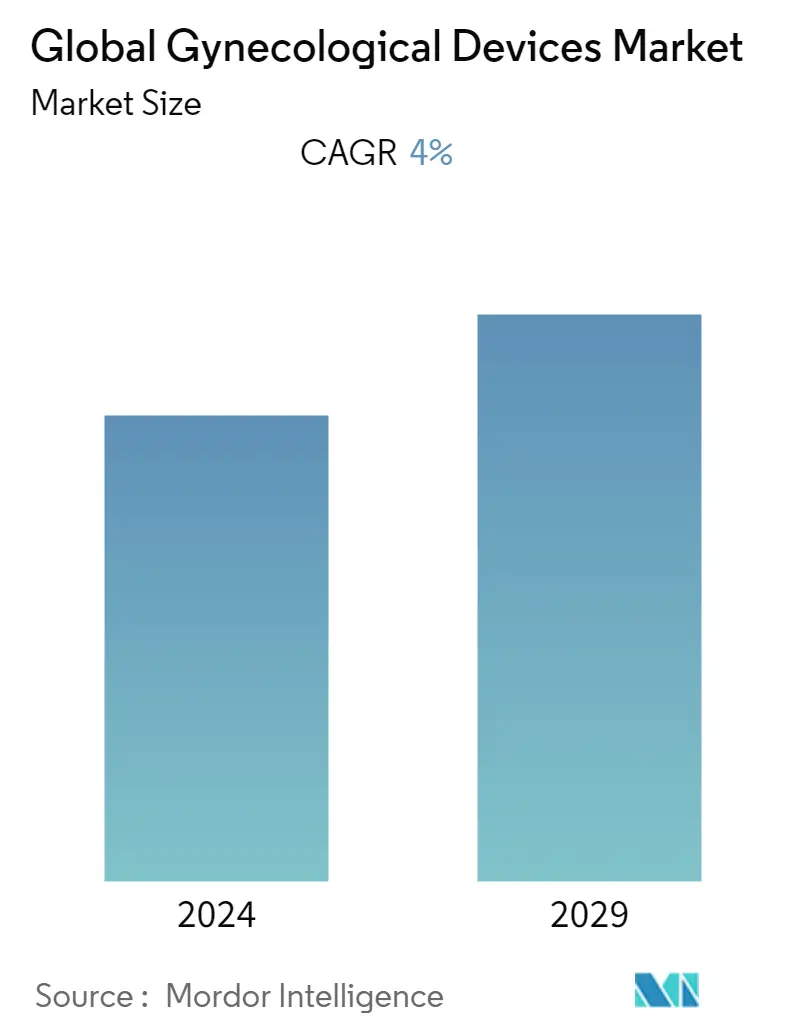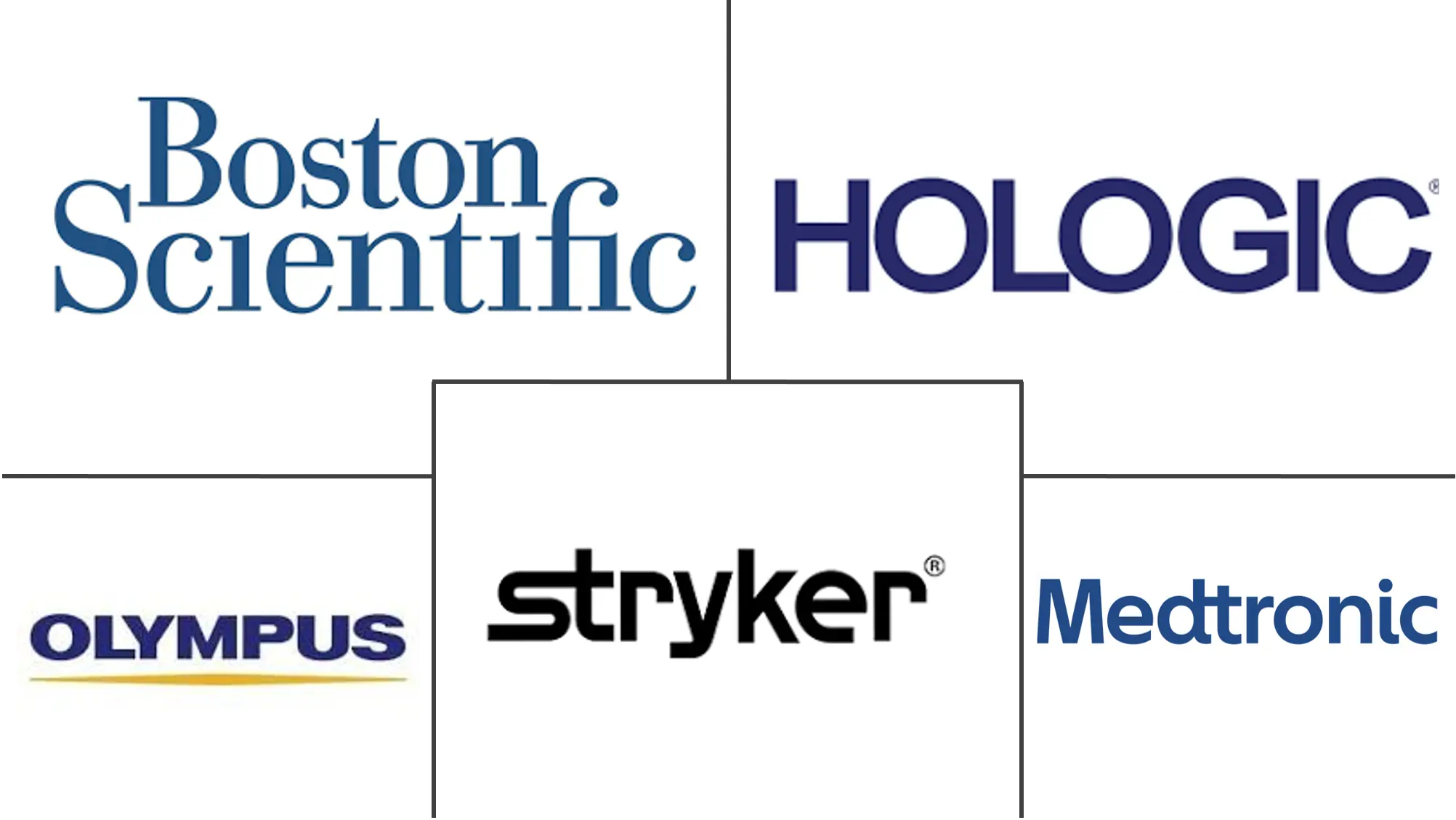Market Size of Global Gynecological Devices Industry

| Study Period | 2019 - 2029 |
| Base Year For Estimation | 2023 |
| CAGR | 4.00 % |
| Fastest Growing Market | Asia-Pacific |
| Largest Market | North America |
| Market Concentration | Low |
Major Players
*Disclaimer: Major Players sorted in no particular order |
Gynecological Devices Market Analysis
The gynecological devices market is expected to register a CAGR of 4% over the forecast period.
COVID-19 had a significant impact on the overall healthcare industry including the gynecological devices market. For instance, as per the article published in December 2021 under the title 'Effects of the COVID-19 pandemic on obstetrics and gynecology residency training in Turkey', important interventions in obstetrics and gynecology, such as emergent cesarean section or labor, make obstetrics and gynecology an emergent department. The trainees had to utilize gynecological devices and endoscopes as a part of their procedures. Therefore, when dealing with emergent interventions, trainees were faced with the risk of virus contamination from asymptomatic COVID-19 cases. Even with well-equipped or qualified workers, interventions might go wrong when there was high stress during obstetrics and gynecological care. Furthermore, as per the article published in January 2022 under the title 'Laparoscopic gynecological surgery in COVID-19 pandemic', for some urgent treatments, like ruptured ectopic pregnancy and ovarian torsion, laparoscopy is the best option. But there are some concerns among surgeons everywhere about the potential for SARS-CoV-2 transmission through the development of a pneumoperitoneum during laparoscopy. Hence COVID-19 had a significant impact on the gynecological devices market.
An increase in gynecological disorders, such as ovarian cancer, cervical cancer, uterine cancer, vaginal cancer, and vulvar cancer, is driving the market for gynecological devices across the world. The American Cancer Society 2022 update stated that the average age of endometrial cancer diagnosis in women is 60, whereas it isn't common amongst women below the age of 45. Furthermore, about 65,950 new cases of cancer of the body of the uterus (uterine body or corpus) were diagnosed in 2022 in the United States. These estimates include both endometrial cancers and uterine sarcomas. Up to 10% of uterine body cancers are sarcomas, so the actual numbers for endometrial cancer cases and deaths are slightly lower than these estimates.
In addition, The World Health Organization 2022 update stated that, with an anticipated 604,000 new cases in 2020, cervical cancer is the fourth most common malignancy in women worldwide. 90% of the anticipated 342,000 cervical cancer deaths in 2020 took place in low- and middle-income nations. The high mortality rate from cancer could be reduced through a comprehensive approach that includes prevention, early diagnosis, effective screening, and treatment programs. This, in turn, leads to high demand for gynecological devices globally. Furthermore, the increased awareness regarding gynecological health is a major fuelling factor for the market growth. For instance, in September 2022, the Rivkin Center for Ovarian Cancer and the American Association for Cancer Research is presenting the 'Virtual Ovarian Cancer Research Series'. The goal of the seminar series is to bring together clinicians and researchers from across many disciplines and institutions worldwide to share ideas and advance the field of ovarian cancer research.
Hence as per the factors mentioned above, the gynecological devices market is likely to grow over the forecast period. However, stringent regulatory guidelines relating to the devices restrain the market growth.
Gynecological Devices Industry Segmentation
As per the scope of the report, gynecological devices refer to surgical and monitoring devices used for gynecological conditions and disorders, such as fluid management, endometrial ablation, gynecological endoscopy, and contraceptive devices. The Gynecological Devices Market is segmented by Product Type (Gynecological Endoscopy Devices, Endometrial Ablation Devices, Contraceptive Devices, Diagnostic Imaging Systems, Fluid Management Systems, and Other Product Types) and Geography (North America, Europe, Asia-Pacific, South America, Middle East, and Africa). The market report also covers the estimated market sizes and trends for 17 countries across major regions globally. The report offers the value (in USD million) for the above segments.
| By Product Type | |||||||
| |||||||
| |||||||
| |||||||
| Diagnostic Imaging Systems | |||||||
| Fluid Management Systems | |||||||
| Other Product Types |
| Geography | ||||||||
| ||||||||
| ||||||||
| ||||||||
| ||||||||
|
Global Gynecological Devices Market Size Summary
The gynecological devices market is poised for growth, driven by an increasing prevalence of gynecological disorders such as various types of cancer, including ovarian, cervical, uterine, vaginal, and vulvar cancers. The demand for these devices is further fueled by heightened awareness of gynecological health and advancements in medical technology. The market has experienced challenges due to the COVID-19 pandemic, which impacted healthcare operations and raised concerns about virus transmission during procedures. However, the need for effective screening, early diagnosis, and treatment programs continues to support market expansion. The endometrial balloon ablation devices segment, in particular, is expected to see rapid growth due to its advantages over traditional surgical methods, such as quicker recovery times and minimal invasion.
North America holds a significant share of the gynecological devices market, attributed to the high incidence of gynecology-related cancers, a robust healthcare infrastructure, and the presence of leading device manufacturers. The region's market growth is also supported by increased awareness campaigns and strategic mergers and acquisitions among key players. Companies like Hologic, Inc. and Boston Scientific Corporation are actively enhancing their product offerings through innovations and acquisitions, further bolstering market competition. The market remains moderately competitive, with several global companies contributing to its development through new product launches and technological advancements.
Global Gynecological Devices Market Size - Table of Contents
-
1. MARKET DYNAMICS
-
1.1 Market Overview
-
1.2 Market Drivers
-
1.2.1 Increasing Prevalence of Gynecological Disorders and Rise in Surgical Procedures
-
1.2.2 Growing Public Awareness
-
-
1.3 Market Restraints
-
1.3.1 Stringent Regulatory Guidelines
-
-
1.4 Porter's Five Forces Analysis
-
1.4.1 Threat of New Entrants
-
1.4.2 Bargaining Power of Buyers/Consumers
-
1.4.3 Bargaining Power of Suppliers
-
1.4.4 Threat of Substitute Products
-
1.4.5 Intensity of Competitive Rivalry
-
-
-
2. MARKET SEGMENTATION (Market Size by Value - USD Million)
-
2.1 By Product Type
-
2.1.1 Gynecological Endoscopy Devices
-
2.1.1.1 Hysteroscope
-
2.1.1.2 Resectoscope
-
2.1.1.3 Colposcope
-
2.1.1.4 Laparoscope
-
2.1.1.5 Endoscopic Imaging Systems
-
-
2.1.2 Endometrial Ablation Devices
-
2.1.2.1 Balloon Ablation Devices
-
2.1.2.2 Hydrothermal Ablation Devices
-
2.1.2.3 Radiofrequency Ablation Devices
-
2.1.2.4 Other Endometrial Ablation Devices
-
-
2.1.3 Contraceptive Devices
-
2.1.3.1 Temporary Birth Control
-
2.1.3.2 Permanent Birth Control
-
-
2.1.4 Diagnostic Imaging Systems
-
2.1.5 Fluid Management Systems
-
2.1.6 Other Product Types
-
-
2.2 Geography
-
2.2.1 North America
-
2.2.1.1 United States
-
2.2.1.2 Canada
-
2.2.1.3 Mexico
-
-
2.2.2 Europe
-
2.2.2.1 Germany
-
2.2.2.2 United Kingdom
-
2.2.2.3 France
-
2.2.2.4 Italy
-
2.2.2.5 Spain
-
2.2.2.6 Rest of Europe
-
-
2.2.3 Asia-Pacific
-
2.2.3.1 China
-
2.2.3.2 Japan
-
2.2.3.3 India
-
2.2.3.4 Australia
-
2.2.3.5 South Korea
-
2.2.3.6 Rest of Asia-Pacific
-
-
2.2.4 Middle East & Africa
-
2.2.4.1 GCC
-
2.2.4.2 South Africa
-
2.2.4.3 Rest of Middle East & Africa
-
-
2.2.5 South America
-
2.2.5.1 Brazil
-
2.2.5.2 Argentina
-
2.2.5.3 Rest of South America
-
-
-
Global Gynecological Devices Market Size FAQs
What is the current Global Gynecological Devices Market size?
The Global Gynecological Devices Market is projected to register a CAGR of 4% during the forecast period (2024-2029)
Who are the key players in Global Gynecological Devices Market?
Boston Scientific Corporation, Hologic, Inc., Medtronic PLC, Olympus Corporation and Stryker Corporation are the major companies operating in the Global Gynecological Devices Market.

